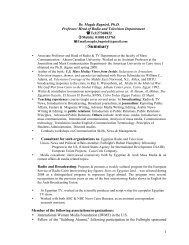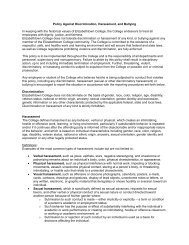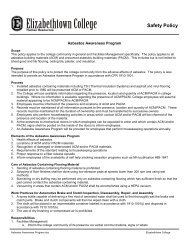Download the Strategic Plan - Elizabethtown College
Download the Strategic Plan - Elizabethtown College
Download the Strategic Plan - Elizabethtown College
You also want an ePaper? Increase the reach of your titles
YUMPU automatically turns print PDFs into web optimized ePapers that Google loves.
©2012 MAY 2012 — Page | 1
©2012 MAY 2012 — Page | 2<br />
VISION STATEMENT<br />
<strong>Elizabethtown</strong> <strong>College</strong> aspires to position itself as a nationally recognized college over <strong>the</strong><br />
next five years. Building on its strengths as a successful undergraduate institution which is<br />
committed to <strong>the</strong> motto “Educate for Service,” <strong>the</strong> <strong>College</strong> will distinguish itself through its<br />
innovative integration of liberal arts and professional studies. The <strong>College</strong> will develop highachieving<br />
students, engaging <strong>the</strong>m through mentorship, high impact practices of experiential<br />
learning, and integrated curricular and co-curricular opportunities. With a signature emphasis<br />
on global understanding and peace and a commitment to inclusive excellence, <strong>the</strong> <strong>College</strong><br />
will educate students for a changing and more diverse world. Highlighting <strong>the</strong> geographic<br />
advantage of <strong>the</strong> <strong>College</strong>’s location in Lancaster County near Harrisburg, <strong>the</strong> <strong>College</strong> will<br />
bolster its sense of place as well as its heritage values of peace, justice, and human dignity.<br />
As a national leader in <strong>the</strong> education of adult learners, <strong>Elizabethtown</strong> <strong>College</strong> will fur<strong>the</strong>r<br />
streng<strong>the</strong>n its continuing education program as an innovative and effective center in<br />
accelerated and distance learning. By 2017, <strong>Elizabethtown</strong> <strong>College</strong> will be nationally<br />
recognized as an innovative institution with a unique focus on creating pathways that promote<br />
real-world learning, making <strong>the</strong> campus an even more vital and engaging community and<br />
stewarding resources to carry out its mission at a higher level. By focusing on <strong>the</strong>se goals,<br />
<strong>Elizabethtown</strong> <strong>College</strong> will meet <strong>the</strong> following challenges facing American higher education:<br />
1. Intense competition among colleges and for-profit institutions for a slow-growing pool of<br />
traditional age applicants;<br />
2. A lively debate over how colleges should best deliver educational experiences for a<br />
rapidly-changing, more diverse, environmentally-conscious, and global world;<br />
3. Concern about <strong>the</strong> value of a traditional college education, given graduates’ difficult<br />
employment prospects and indebtedness<br />
The <strong>Strategic</strong> <strong>Plan</strong> meets <strong>the</strong>se challenges by identifying <strong>the</strong> unique qualities of <strong>the</strong><br />
traditional/residential program, qualities that differentiate <strong>Elizabethtown</strong> from o<strong>the</strong>r private<br />
colleges. In <strong>the</strong> spirit of remaining true to <strong>the</strong> <strong>College</strong>’s mission and academic standards, <strong>the</strong><br />
<strong>Plan</strong> advances <strong>the</strong> continuing education program for working adults by providing access to<br />
programs of excellence. The unique quality of <strong>the</strong> learning environment and institutional cost<br />
effectiveness make <strong>Elizabethtown</strong> <strong>College</strong> an excellent value for those pursuing a college<br />
education.
©2012 MAY 2012 — Page | 3
©2012 MAY 2012 — Page | 4<br />
GOAL 1: NATIONAL RECOGNITION<br />
Gain recognition as a national baccalaureate college by turning<br />
attributes into advantages.<br />
STRATEGIES<br />
1. University Offerings in a <strong>College</strong> Setting: Affirm <strong>the</strong> <strong>College</strong>’s balance of arts & sciences and<br />
professional degree programs and market both <strong>the</strong> breadth and integration of <strong>the</strong>se offerings as a<br />
competitive advantage.<br />
2. Develop High Achieving Students: Demonstrate <strong>the</strong> <strong>College</strong>’s success in developing high-achieving<br />
students by identifying pathways for real-world learning, a program that engages students through<br />
mentorship, high impact practices of experiential learning and integrated curricular and co-curricular<br />
opportunities. Real-world learning moves students towards greater intellectual challenge and<br />
meaningful life work.<br />
3. “Educate for Service”: Promote <strong>the</strong> <strong>College</strong> motto, “Educate for Service,” in preparation for<br />
purposeful life work through community-based learning, civic engagement and internships.<br />
4. Global Understanding and Peacemaking: Enhance opportunities for international engagement and<br />
streng<strong>the</strong>n programs and curricula related to international studies, peacemaking and interfaith dialogue.<br />
5. Inclusive Excellence: Build upon <strong>the</strong> <strong>College</strong>’s commitment to Inclusive Excellence in order to<br />
increase diversity among students, faculty, and staff and to enhance learning opportunities that are<br />
multicultural, inclusive, and accessible to all students.<br />
6. Location: Identify Lancaster County, Harrisburg and <strong>the</strong> surrounding region as resources for learning<br />
and service and as a way to identify our location in <strong>the</strong> public mind.<br />
7. Heritage: Advance programs such as <strong>the</strong> Young Center that reflect <strong>the</strong> <strong>College</strong>’s heritage, values, and<br />
history.<br />
8. Excellence in Adult Education: Offer high quality undergraduate and graduate degree programs to<br />
adult learners in a mission-aligned yet distinct educational unit.<br />
9. Marketing: Develop <strong>the</strong> <strong>College</strong>’s marketing plan including new strategies to gain national recognition.
©2012 MAY 2012 — Page | 5
©2012 MAY 2012 — Page | 6<br />
GOAL 2: REAL-WORLD LEARNING<br />
Foster a campus culture that provides all students with pathways<br />
and opportunities for real-world learning.<br />
STRATEGIES<br />
1. Learning Pathways: Designate intentional pathways and advising for all students that integrate<br />
curricular and co-curricular learning, provide “high impact practices” such as undergraduate research,<br />
internships, study abroad, and civic engagement, and encourage student assessment of individual<br />
learning and progress toward institutional learning goals.<br />
2. Problem-based Learning: Increase curricular and co-curricular learning experiences which focus on<br />
real-world issues, ethical questions and unscripted challenges. Infuse problem-based learning with<br />
au<strong>the</strong>ntic consultations by alumni practitioners and o<strong>the</strong>r regional experts.<br />
3. Mentoring Partnerships and Career Preparation: Promote mentorship and collaborative work for all<br />
students with faculty, staff, alumni, parents and community and corporate leaders; increase internship<br />
opportunities; and streng<strong>the</strong>n planning for careers and graduate school.<br />
4. Expanded Opportunities for Learning: Create new opportunities within <strong>the</strong> academic calendar to<br />
support more innovative, problem-based pedagogy such as semester immersion experiences and<br />
short-term focused study (January/Summer/May term).<br />
5. Instructional Technology: Increase <strong>the</strong> effective integration of instructional technology, including<br />
classroom, on-line and hybrid courses, social media, and internet-based research and publication.<br />
6. Residential Learning: Expand collaborative living-learning opportunities and develop a residential<br />
renewal plan in support of a high-quality residential learning experience.<br />
7. Athletics, Fitness and Wellness: Build strong athletic, fitness and wellness programs and develop a<br />
plan for new facilities to advance <strong>the</strong>se initiatives.<br />
8. Graduate Programs: Develop two or three additional graduate programs based on academic strength,<br />
financial viability and market demand.
©2012 MAY 2012 — Page | 7
©2012 MAY 2012 — Page | 8<br />
GOAL 3: STEWARDSHIP OF RESOURCES<br />
Ensure <strong>the</strong> sustainability of <strong>the</strong> <strong>College</strong> by streng<strong>the</strong>ning and<br />
stewarding human, financial, technology and physical resources.<br />
STRATEGIES<br />
1. Faculty and Staff: Recruit, develop, recognize and reward a high quality and diverse workforce.<br />
2. Alumni Engagement: Recognize alumni interests and build programs that foster relationships among<br />
alumni, students, faculty and staff members for <strong>the</strong> purpose of streng<strong>the</strong>ning alumni affinity for <strong>the</strong><br />
<strong>College</strong>. Engagement opportunities include student mentorship, collaborative admissions work, and<br />
interaction with academic programs.<br />
3. Fundraising: Expand <strong>the</strong> <strong>College</strong>’s annual and capital fundraising capacity.<br />
4. Sponsored Research and Programs: Establish an Office of Sponsored Research and Programs to<br />
increase external support for faculty and undergraduate research and campus programs.<br />
5. Enrollment: Develop a five-year enrollment and financial aid plan to increase undergraduate and<br />
graduate enrollment in <strong>the</strong> traditional program to 2,000; and develop a five-year enrollment plan in<br />
Continuing Education.<br />
6. Streng<strong>the</strong>n and Expand Programs: Identify programs with potential for enrollment growth and<br />
implement plans to expand <strong>the</strong>se programs while maintaining quality and appropriate faculty, staff,<br />
facilities, budgetary support, and balance of degrees.<br />
7. Information Technology: Develop a five-year IT plan aligned with <strong>the</strong> <strong>Strategic</strong> <strong>Plan</strong> outlining needed<br />
information technology investments related to instructional and business process activities.<br />
8. Master Facilities <strong>Plan</strong>: Develop a master facilities plan aligned with strategic objectives, mapping out<br />
<strong>the</strong> on-going care and renovation of campus facilities and identifying new construction such as an<br />
athletic/recreational center and a new residence hall.<br />
9. Environmental Stewardship: Streng<strong>the</strong>n, coordinate, and advance <strong>the</strong> <strong>College</strong>’s commitment to <strong>the</strong><br />
values and practices of environmental sustainability through expanded programs, comprehensive<br />
planning, and designation of a campus sustainability coordinator.<br />
10. Financial <strong>Plan</strong>ning: Affirm principles that support a sustainable financial position and align financial<br />
resources and personnel with <strong>the</strong> <strong>Strategic</strong> <strong>Plan</strong>, using such means as administrative and academic<br />
unit reviews, position audits, focused budgeting methods, and guidelines for incremental improvements<br />
in financial projections.









